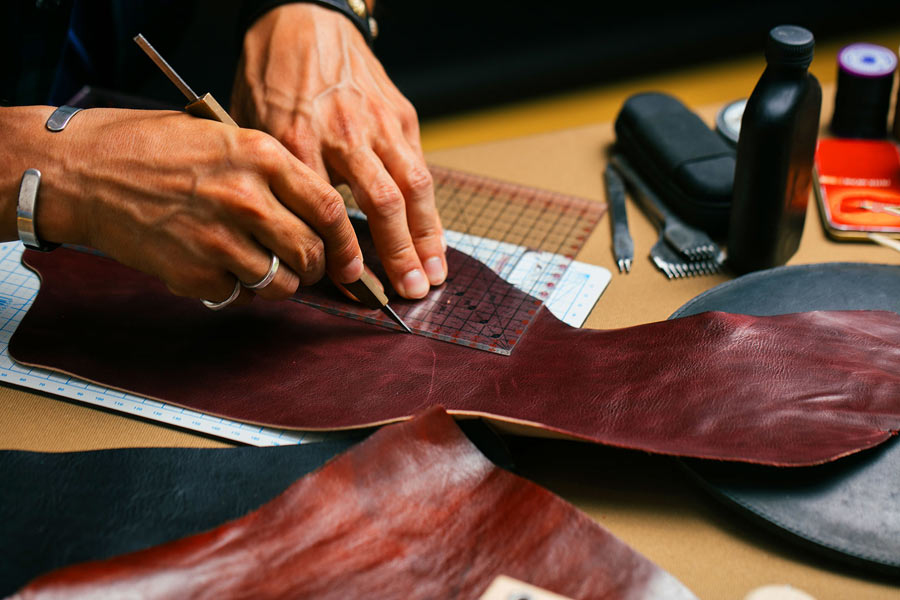
06 Jul 5 Trends in Modern Leather Crafting: Staying Ahead in a Traditional Art
Leather crafting, an age-old art, has beautifully evolved over the years. While it holds steadfast to its traditional roots, modern innovations are pushing its boundaries, creating a fascinating blend of old and new. In an industry where heritage craftsmanship meets cutting-edge technology, staying updated with current trends is crucial. Let’s dive into five trends that are shaping the future of leather crafting, ensuring artisans stay ahead in this ever-evolving field.
Trend #1: Technological Integration in Design
Gone are the days when leather design was solely a hands-on process. Today, digital tools and software are revolutionizing how artisans create and perfect their designs. Technologies like CAD (Computer-Aided Design) and CAM (Computer-Aided Manufacturing) have become game-changers.
Imagine crafting intricate patterns with precise accuracy using 3D modeling. These tools allow for meticulous planning and flawless execution, reducing waste and enhancing efficiency. Leather crafters can now experiment with designs virtually, making adjustments before cutting into the actual material. This integration of technology not only streamlines the design process but also opens up a world of creative possibilities.
Trend #2: Sustainability in Leather Sourcing
As consumers become more environmentally conscious, the leather industry is seeing a significant shift towards sustainable practices. Eco-friendly and ethical leather sourcing is no longer just a niche market but a growing trend.
Sustainably sourced leather often involves using hides from animals that are part of the food industry, ensuring that no part of the animal goes to waste. Additionally, vegetable tanning, a traditional method that uses natural tannins from plants, is making a strong comeback. It’s gentler on the environment compared to chemical tanning processes. By adopting these practices, leather artisans are not only contributing to environmental conservation but also meeting the rising demand for eco-friendly products.
Trend #3: Artisan Collaborations and Community Building
In the age of social media and global connectivity, collaboration has become a powerful trend. Leather artisans are increasingly partnering with other craftsmen, designers, and even tech experts to create unique products.
These collaborations foster a rich exchange of ideas and skills, leading to innovative creations that might not have been possible in isolation. Furthermore, community building through workshops, online forums, and craft fairs allows artisans to network, share knowledge, and stay inspired. This sense of community strengthens the leather crafting industry, promoting growth and continuous learning.
Trend #4: Innovative Leather Finishes and Treatments
Advancements in leather finishes and treatments are enhancing both the durability and aesthetics of leather products. Today, you can find leather that’s water-resistant, stain-resistant, and even scratch-resistant, thanks to new finishing techniques.
Natural dyes are becoming popular, offering a wide range of hues while being kind to the environment. Innovative tanning processes, such as chrome-free tanning, are reducing the environmental impact of leather production. These treatments not only improve the functionality of leather goods but also appeal to consumers looking for high-quality, long-lasting products.
Trend #5: Customization and Personalization
The demand for bespoke leather goods and personalized designs is soaring. Consumers are no longer satisfied with mass-produced items; they seek unique products that reflect their personal style and preferences.
Leather artisans are rising to the occasion by offering customization options. Whether it’s monogramming, choosing specific colors and finishes, or creating entirely custom designs, personalization adds significant value. Advanced techniques like laser engraving and embossing allow for intricate details that make each piece one-of-a-kind. This trend highlights the importance of understanding and catering to individual customer needs, ensuring satisfaction and loyalty.
Conclusion
The leather crafting industry is at an exciting crossroads, where tradition meets innovation. By embracing technological integration, sustainable practices, collaborative efforts, advanced finishes, and personalized services, leather artisans can stay relevant and competitive. These trends not only enhance the quality and appeal of leather goods but also align with the evolving preferences of today’s consumers.
As we look to the future, it’s clear that staying ahead in this traditional art requires a harmonious blend of old-world craftsmanship and modern ingenuity. So, whether you’re an established artisan or a budding leather crafter, keeping an eye on these trends will help you craft a path to success.


